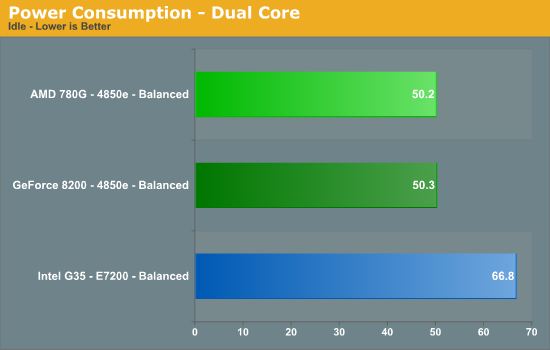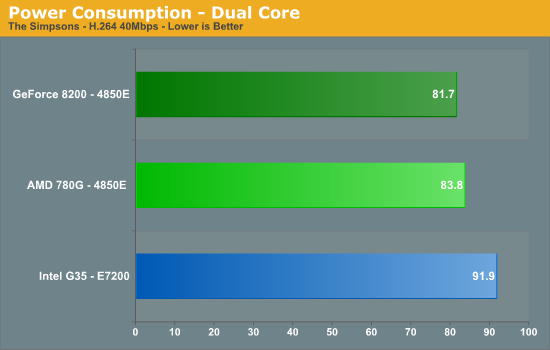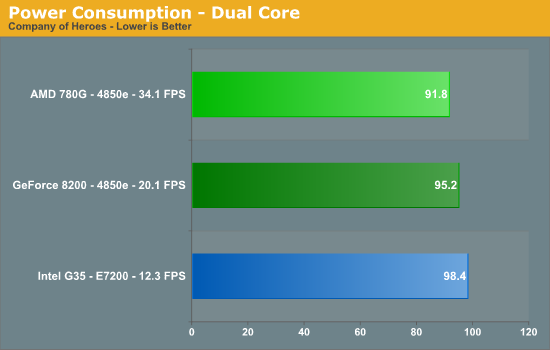We took a first look at power consumption numbers from the latest integrated graphics platforms and came away with some surprising results at the time. As we mentioned in the original article, our initial focus was on the platform and not chipsets. Little did we know the reaction this focus would create from both the manufacturers and readership. As expected, the chipset/processor manufacturers had their own opinions about our results and offered a wealth of information about their internal results and test practices.
We learned a great deal, about how Intel, NVIDIA, and AMD arrive at their reported numbers, but more importantly that each company arrives at their final results just a little differently. We will get into that subject matter and more in our first specific power consumption article. As for today, we are going to provide some quick results based on our current testbeds utilizing the AMD 780G, NVIDIA GF8200, and Intel G35 chipsets.
After completing power consumption numbers on twelve boards (results on Monday) featuring these latest chipsets, it became obvious that each manufacturer implements power management capabilities of the chipsets and processors in a variety of ways. Even testing the same chipset from two different board suppliers with like BIOS options resulted in measurable differences. Based on previous testing this was not a real surprise to us. However, after specifically focusing on power management capabilities the differences in options between each BIOS and even how standard features are implemented shocked us to some degree. At least to a degree that we will spend significantly more time and effort on reporting power management options and results in future articles.


In our first article, we utilized boards from different manufacturers, enabled each power option available in the BIOS and standardized Vista's power management schemes. Although each BIOS option appeared similar, the results turned out to be quite different between manufacturers. In fact, it was the power management features missing that provided the biggest differences between boards.
After weeks of discussion with AMD, Intel, and NVIDIA about the variety of power management options available in the core BIOS code and then comparing that information to what the supplier implements, we turned our attention to the board suppliers to provide significantly better power management features. Not only have most responded with improved features or performance, it also appears a greater emphasis from the chipset manufacturers is occurring at this time on new product releases.
As such, our testing today will utilize boards from Biostar for the AMD 780G and GeForce 8200 chipsets. The reason being is that most board suppliers will utilize like BIOS code and features along with components for their entry level boards in order to save costs. Biostar does not supply a G35 board so we will stick with our ASUS sample. ASUS also offers 780G/GF8200 boards that are very similar to each other in design and price. However, the current boards are being phased out. They will be replaced shortly by new boards with improved feature sets and the capability to handle 140W TDP processors.
The important point to make here is that 780G/GF8200 boards from Jetway and ASRock each had very similar BIOS options and board layouts that resulted in comparative numbers between these two chipsets. Our two Biostar boards do differ, as the 780G is a uATX format while the GF8200 is a standard ATX format board. However, the Biostar GF8200 board offered the best power consumption numbers in our roundup testing so we will use it as a best-case example. The same applies for the 780G board from Biostar.
Since our initial article, each board has received several BIOS upgrades along with significant driver changes from the chipset manufacturers. In doing A/B comparisons between each BIOS and driver change, we did notice improvements in power management for the Intel and AMD products while the NVIDIA numbers increased slightly due to additional performance and features provided by the latest driver set. We also changed our power supply, fan count, hard drive, and memory components to represent our standard test bed options for future articles.



At idle, the 780G and GF8200 basically tie now. In previous testing with the Gigabyte 780G board, the 780G was about 7W higher at idle than the Biostar GF8200. The Intel G35 dropped about 8W after the 0506 BIOS update along with a change in the retail cooler for the E7200. The H.264 playback numbers favor the AMD and NVIDIA chipsets as they feature hardware acceleration for H.264 that Intel is lacking until the G45 arrives. However, the Intel number did improve around 12W after the latest BIOS, driver, and PowerDVD Ultra updates. In our final test, the GF8200 performs the best from a pure wattage vantage viewpoint. The 780G actually has the best performance per watt rating based on a 70% increase in frame rates with only a 5% increase in power compared to the GF8200. The G35 is not recommended for most recent game titles so we will not even comment further on its results.
We will be back on Monday with a look at several different boards and further information about power management features along with performance per watt in additional titles. In the meantime, we were impressed with the attention Biostar has placed on power management in their IGP boards along with the improvements of our G35 board after a series of BIOS and driver upgrades.










30 Comments
View All Comments
Spoelie - Thursday, June 19, 2008 - link
how about using a 45w intel cpu?ow wait..
tshen83 - Thursday, June 19, 2008 - link
That's a retarded response, since you know that Intel doesn't focus on low power dual cores at 45W desktop chips. It is not difficult if Intel decides to eat AMD up in that space too. All they have to do is to test their 45nm chips with a more strict TDP rating. Their low power part exist in dual socket space with the L5400 series 50W for 4 cores at 2.66Ghz, beats AMD's 4 cores at 3Ghz. Does AMD have anything that good. Oh wait. That's right. AMD has to fudge their power with ACP too.Plus that 45W Athlon x2 hardly does more work per watt. 65W 7200 easily outperforms the special edition low watt athlon on the Performance per Watt metric. yes 20W more power, 40% more performance too. Did you discount that?
So go screw yourself. L5400 series Xeons is where low power is at. AMD can lie about their ACP all they want.
To really kick your ass, how about using a 2W dual core Atom CPU?
q93 - Thursday, June 26, 2008 - link
the atom cpu is not dual core dumb-ass, it uses hyperthreading. and its about the igp, he could easily use a via c-7 and a chrome igp and use way less w, but thats beyond the scope of this article.derek85 - Thursday, June 19, 2008 - link
How is that 40% more performance from E7200 if they were performing the same task and both done equally well while Intel consumes 20W more? Your logic is flawed.You should look at this from a platform point of view. And it is clearly that the Intel platform requires more W than both AMD platforms to complete the same task, and I believe we can translate that directly into inefficiency.
ksherman - Thursday, June 19, 2008 - link
Well someone has a small kitten stuck up where the sun don't shine..Thanks for the update Gary! Shows us mostly that the AMD chipset is definietly the better buy. Sure, the Intel chip *might* be running a little more power than the AMD ones, who cares? The article is about the IGP platforms, where clearly Intel isn't even in the same hemisphere as the nVidia and AMD solutions both in terms of performance and likely in power consumption as well.
tshen83 - Thursday, June 19, 2008 - link
Retard. That's all I have to say about you.wh3resmycar - Friday, June 20, 2008 - link
will it even matter what processor was used? i mean come on, the g35 was pawned to dust here. sure you can use another low power consuming processor from intel but will those fps catch up? i dont think soEiny0 - Thursday, June 19, 2008 - link
I wonder if this guy works for Intel lol... Seriously power consumption aside, AMD and Nvidia IGPs blow the doors off the G35. Power consumption I'd bet might be more of a toss up. Hell look at the FPS on CoH. The 780G is insane for an IGP.R3MF - Thursday, June 19, 2008 - link
watch your mouth.tshen83 - Thursday, June 19, 2008 - link
Oh one more thing: you should be shorting AMD right now. 5 bux by Christmas.